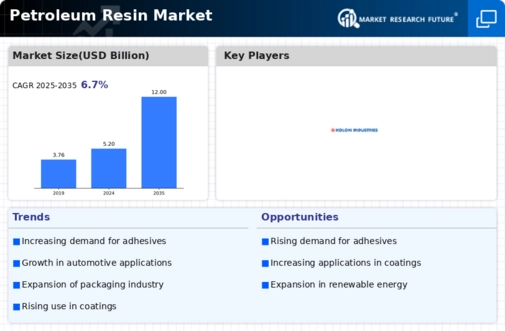Market Trends
Key Emerging Trends in the Petroleum Resins Market
Hot-melt adhesives have become increasingly popular in recent years due to their cost-effectiveness and favorable regulatory conditions. Unlike traditional adhesives, these compounds are 100% solid thermoplastics, meaning they don't contain solvents or aqueous carriers for the active adhesive components. This solvent-free nature makes them environmentally friendly, reducing their impact on the environment. At room temperature, hot-melt adhesives are in a solid state, but they become liquid when exposed to high temperatures ranging from 120° to 180°C. The application process involves melting the adhesive, applying it in molten form, and allowing it to bond and cool rapidly. This method provides one of the fastest ways to achieve adhesion. For optimal durability, the melting and softening points of these adhesives must exceed their service temperature. Hot-melt adhesives are composed of three main components: polymer, tackifying resin, and wax/oil. Various thermoplastic polymers, such as ethylene-vinyl acetate copolymers (EVAs), polyamides, polyolefins, polyurethane, and polyesters, are used. However, some polymers, especially those with low vinyl acetate content, may exhibit low metal adhesion. To address this, tackifying resins are introduced to enhance wetting characteristics. The term "tack" refers to a material's ability to form a strong bond immediately upon contact with another substrate, often with low or no pressure. This property is crucial in adhesives and sealants. When using hot-melt adhesives, factors like melt viscosity, crystallinity, softening point, melt index, tack, and heat stability are essential for achieving optimal adhesion. Petroleum resin is a key component of hot-melt adhesives, constituting over 70% of the total weight. It offers characteristics such as resistance to thermo-oxidative degradation, non-toxicity, and colorlessness, making it well-suited for adhesive formulations. Tackifying resins play a vital role in these adhesives by reducing viscosity, increasing strength, controlling open time, and maintaining adhesive rigidity. The application temperature of hot-melt adhesives is typically higher, ranging from 149°C to 288°C, even though they melt at around 79.4°C. These adhesives find widespread use in industries such as packaging, automobile assembly, non-woven product manufacturing, and bookbinding. Beyond hot-melt adhesives, petroleum resin also finds applications in solvent-based or waterborne adhesives. In these formulations, petroleum resin enhances tackiness, open time, cohesive strength, and heat resistance. For instance, in polychloroprene-based adhesives, petroleum resin is often combined with terpene phenol resins to further improve tackiness and open time. Overall, the versatility and effectiveness of hot-melt adhesives, along with the contributions of petroleum resin, make them valuable in various industries and adhesive formulations.




Leave a Comment